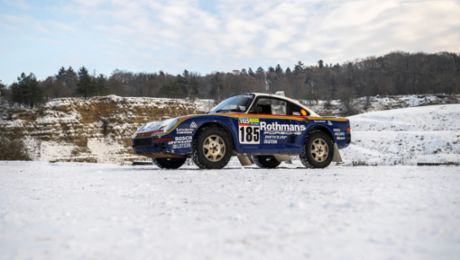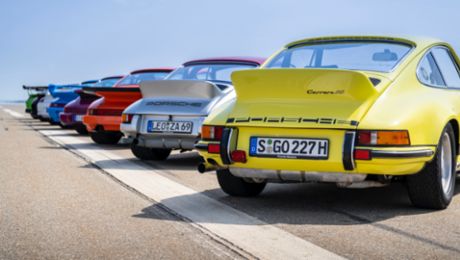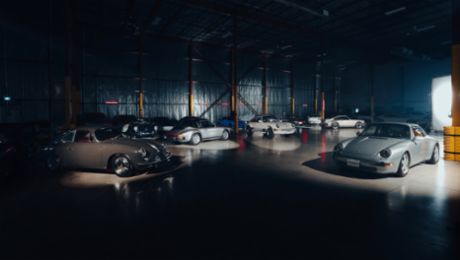Just to be on the safe side, if someone should offer you a 911 Speedster of the 993 series and tell you it's an 'original' – be sceptical! There’s a good chance that it’s a replica because the pure two-seater from the last air-cooled generation of the classic sports car is one of the rarest cars Porsche has ever built. In fact, only two genuine units were made. One was actually sold and the other was given away, but it found its way back to the factory museum on loan. Today it is of inestimable value and is looked after like a fragile egg. It is only allowed out on special occasions, and a photo shoot with the new 911 Speedster just about qualifies. The location of the meeting is also exclusive: the roof terrace of the Porsche Museum. Rarity meets modern legend.
Speedsters are of enormous significance to Porsche. Few models reflect the core brand values of the sports car manufacturer – namely driving pleasure and driving dynamics – as well as these cabriolets which are reduced to the essentials with their compact windscreens. Their genes go back to the 'No. 1, Type 356', the very first Porsche, which is often cited these days given the veritable flood of open-top innovations from Zuffenhausen. However, the 356 1500 America Roadster of 1952 is regarded as the forefather of this body variant. With its emergency folding top, slot-in windows for the doors and lightweight bucket seats, this aluminium sports car – specially developed for the race-mad Americans – shaped key Speedster features. It weighed 60 kilograms less than the 356 Coupé, only 21 units were built and it had a price tag to match.
In the autumn of 1954, a much cheaper sheet steel successor with purist features and an emergency soft top followed: the first 356 Speedster. It cost just 2,995 US dollars in the US and quickly became a hit. The highlight for the time being was the 356 A 1500 GS Carrera GT Speedster in 1957, whose vertical-shaft Fuhrmann engine produced 110 PS. It was Porsche’s first production model to break through the 200 km/h barrier.
Ferdinand Alexander Porsche’s services to the family business are legendary. The eldest son of company founder Ferry and grandson of Prof. Ferdinand Porsche began his career in 1957 in the Porsche body styling studio after briefly studying at the Ulm School of Design in Germany. His extraordinary talent did not remain hidden there for long as he drew the fascinating 904 Carrera GTS almost single-handedly. But he finally made it to the pinnacle of designer achievement with the 911, whose iconic shape he created together with his team – the 911 still bears the signature of "Butzi" Porsche to this day. In 1972 F. A. founded his own design studio in Zell am See, but remained closely associated with the company, and in 1990 he took over the chairmanship of the Supervisory Board of Porsche AG from his father. And when Ferdinand Alexander celebrated his 60th birthday on December 11, 1995, it was time for a token of gratitude and a special gift. The Porsche Exclusive department got to work.
.jpg/jcr:content/low_911_speedster_2019_porsche_ag%20(1).jpg)
Based on a Carrera 2 Cabriolet, an extraordinary one-off model was produced: the green 993 Speedster from the 993 series. The specialists adopted the flat windscreen from the 964 in principle, and the rear lid with the elegant streamliners, including the unconventional locking mechanism with the lever behind the driver's seat, is also similar to its predecessor. A Tiptronic transmission, a dark brown leather interior including RS seats, beautiful wood trim and special storage compartments under the roof stowage compartment rounded off the masterpiece. F. A. is said to have been very pleased, even though he apparently only seldom drove this exclusive one-off model. To this day, there are barely more than 2,000 kilometres on the clock.
The history of the Speedster at Porsche continued. In 2010, the two-seater version of the 997 series followed, with a turbo body and a generous 408 PS, naturally-aspirated boxer engine. Contrary to tradition, this special series, limited to 356 units, was very extensively equipped. Many felt that it was historically incorrect. A Speedster should be light, austere, like a rough diamond and source of pure driving pleasure – a real machine in which emotions explode, adventures escalate, and worries are left behind. A car that no one who's ever had the honour of driving it can forget. A classic of tomorrow for the here and now. The motorsport enthusiasts at the Weissach Development Centre took on this task, naturally with their own approach.
It was no coincidence that they presented their first design exactly 70 years after the brand’s first sports car: Porsche gave itself the present of the 911 Speedster Concept for its anniversary in June 2018. Three quarters of a year later, the series-production version was launched - and it is something to be proud of, even though it will seldom be seen given the limited edition of 1,948 units. For the first time a Speedster was based on a GT model. With the 510 PS, 4.0-litre six-cylinder engine from the 911 GT3, which revs up as greedily as a thoroughbred racing engine and whose screams could trigger addictive symptoms before it is limited at 9,000 rpm: with powerful, controlled throttle blips that give you goosebumps when downshifting. With a GT3 chassis that conveys race track precision and a consistently lightweight construction that is reflected in mysteriously shimmering carbon fibre patterns. At least, where they can be seen – on the underside of the beautifully shaped rear lid, for example, which weighs only ten kilograms including all attachments. And with a lightweight convertible top that even braves car washes.
Without question, the new 911 Speedster – still based on the 991 series – comes closer to the ideal of a light and fast athlete than any other vehicle in a long time. It takes 4.0 seconds for the Speedster to go from 0-100 km/h. After 11.9 seconds, the quarter-mile is history from a standing start. And if you’re in a hurry, you can reach 310 km/h on the motorway. However, the feelings it triggers are difficult to describe because they are simply overwhelming.
One question remains unanswered: What about the second 993 Speedster?
Jerry Seinfeld was responsible for the fact that the one-of-a-kind model built for 'Butzi' Porsche should not remain such. The American actor, star of the sitcom named after him, is an ardent fan of the brand and proud owner of a veritable treasure trove of mostly rare Porsche models. In 1998 he ordered and received a silver 911 Cabriolet. Two years later, he sent the turbo-wide, manual transmission 4S model back across the Atlantic, together with a heartfelt request to transform it into a real Speedster like the prototype. Porsche fulfilled the wish of its good friend. In October 2001, the finished car again embarked on its journey to America. There is thus a second original. So if someone should offer you a 993 Speedster and tell you it's 'genuine', you have been warned ...
.jpg/jcr:content/low_911_speedster_2019_porsche_ag%20(2).jpg)
Info
Text first published in the magazine „Porsche Klassik“, special edition „8 generations 911"
Copyright: The image and sound published here is copyright by Dr. Ing. h.c. F. Porsche AG, Germany or other individuals. It is not to be reproduced wholly or in part without prior written permission of Dr. Ing. h.c. F. Porsche AG. Please contact newsroom@porsche.com for further information.
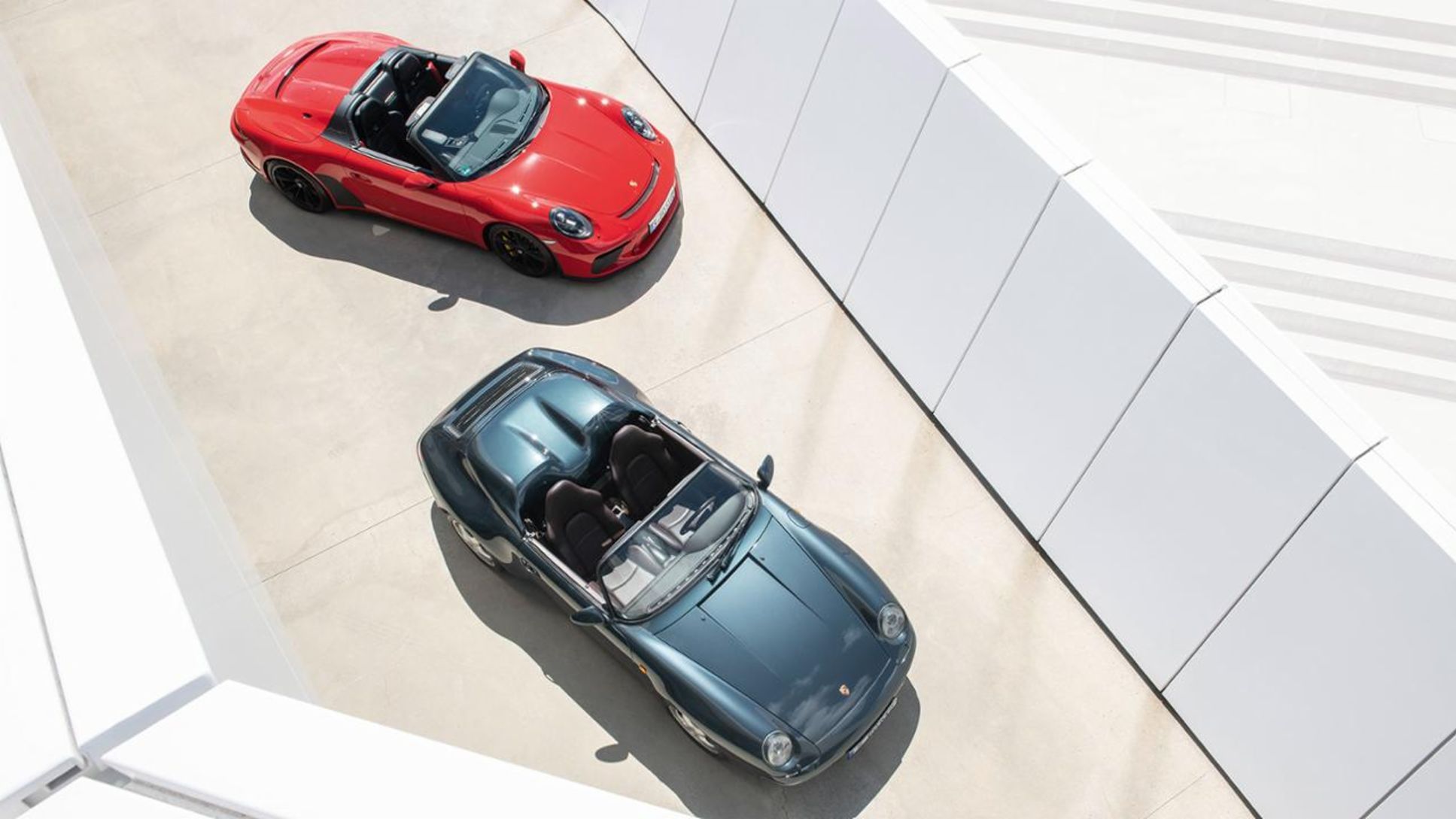
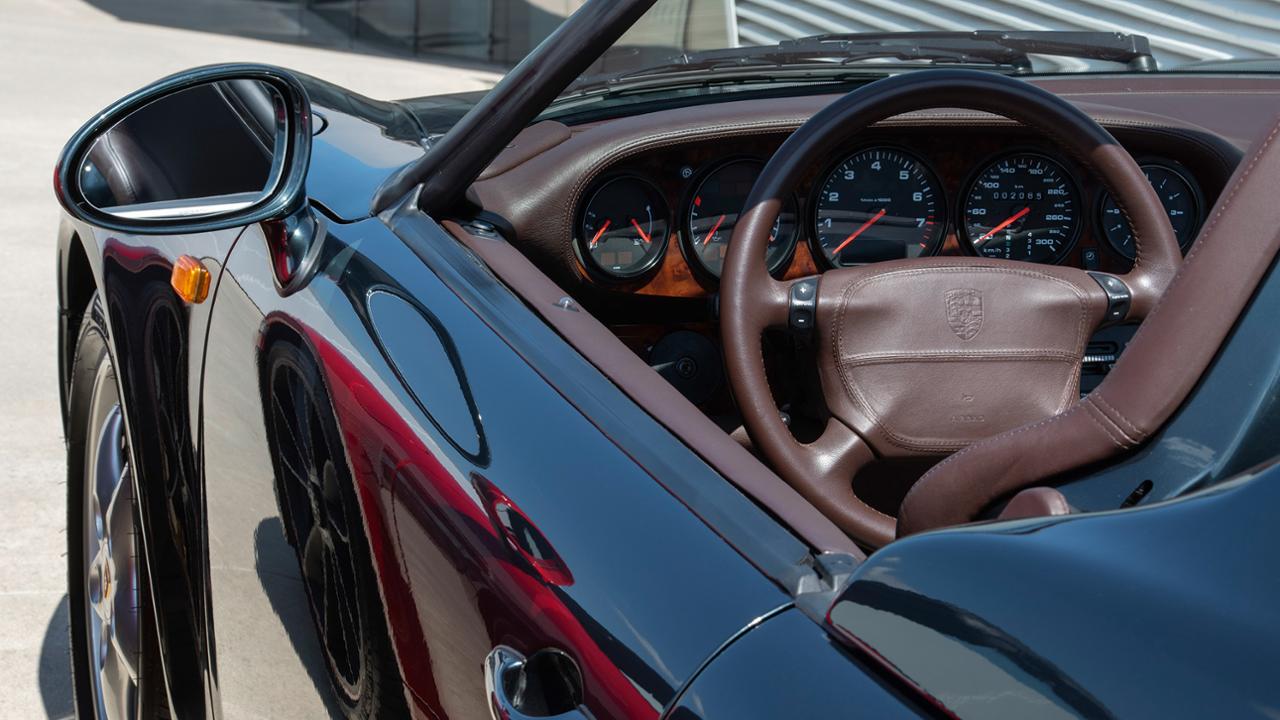
/low_911_speedster_2019_porsche_ag.jpg/jcr:content/low_911_speedster_2019_porsche_ag.jpg)
/low_911_speedster_2019_porsche_ag_1.jpg/jcr:content/low_911_speedster_2019_porsche_ag_1.jpg)
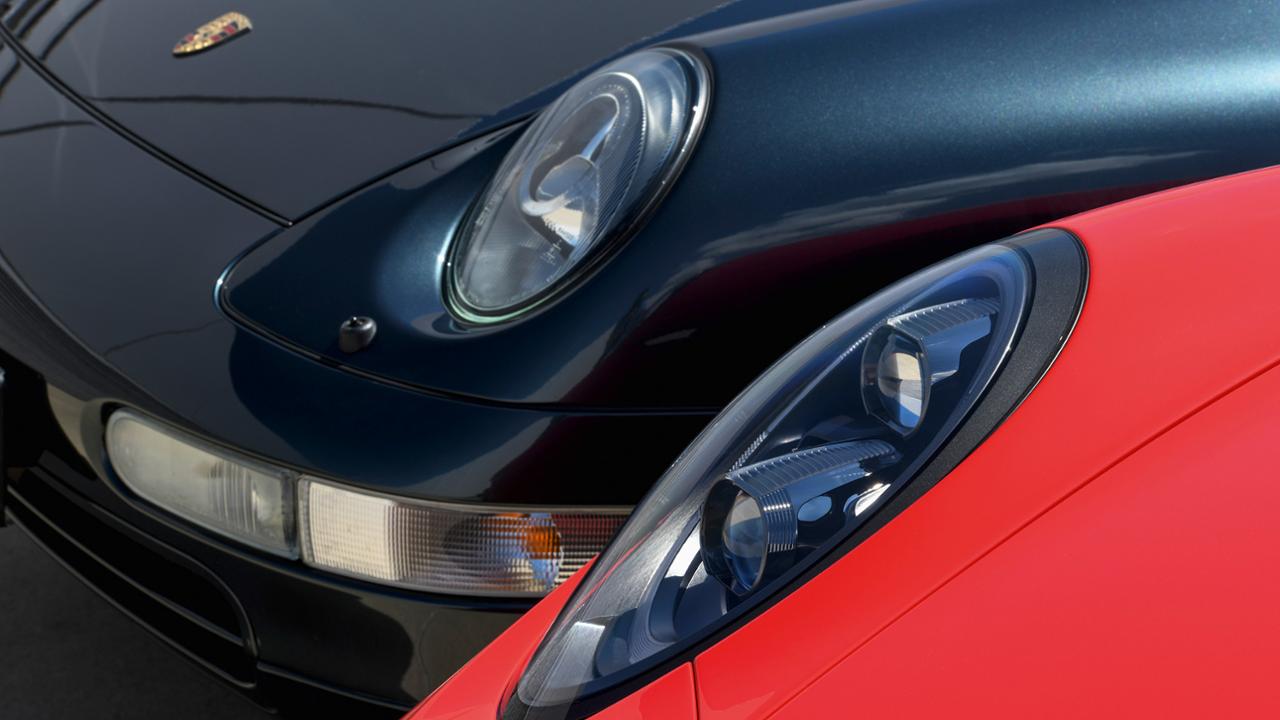
/low_911_speedster_2019_porsche_ag.jpg/jcr:content/low_911_speedster_2019_porsche_ag.jpg)
/low_911_speedster_2019_porsche_ag_1.jpg/jcr:content/low_911_speedster_2019_porsche_ag_1.jpg)


